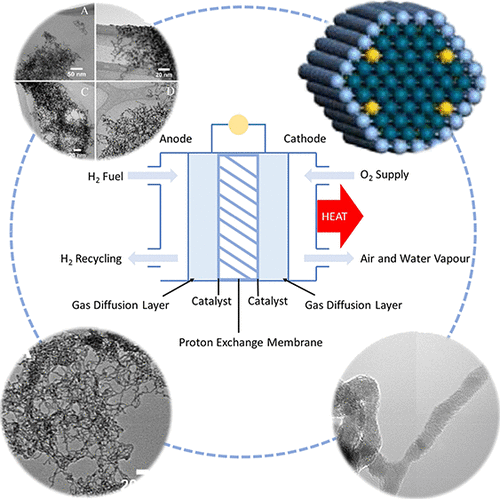Our official English website, www.x-mol.net, welcomes your
feedback! (Note: you will need to create a separate account there.)
Ultrathin Metallic Nanowire-Based Architectures as High-Performing Electrocatalysts
ACS Omega ( IF 3.7 ) Pub Date : 2018-03-19 00:00:00 , DOI: 10.1021/acsomega.8b00169 Luyao Li 1 , Stanislaus S. Wong 1
ACS Omega ( IF 3.7 ) Pub Date : 2018-03-19 00:00:00 , DOI: 10.1021/acsomega.8b00169 Luyao Li 1 , Stanislaus S. Wong 1
Affiliation

|
Fuel cells (FCs) convert chemical energy into electricity through electrochemical reactions. They maintain desirable functional advantages that render them as attractive candidates for renewable energy alternatives. However, the high cost and general scarcity of conventional FC catalysts largely limit the ubiquitous application of this device configuration. For example, under current consumption requirements, there is an insufficient global reserve of Pt to provide for the needs of an effective FC for every car produced. Therefore, it is absolutely necessary in the future to replace Pt either completely or in part with far more plentiful, abundant, cheaper, and potentially less toxic first row transition metals, because the high cost-to-benefit ratio of conventional catalysts is and will continue to be a major limiting factor preventing mass commercialization. We and other groups have explored a number of nanowire-based catalytic architectures, which are either Pt-free or with reduced Pt content, as an energy efficient solution with improved performance metrics versus conventional, currently commercially available Pt nanoparticles that are already well established in the community. Specifically, in this Perspective, we highlight strategies aimed at the rational modification of not only the physical structure but also the chemical composition as a means of developing superior electrocatalysts for a number of small-molecule-based anodic oxidation and cathodic reduction reactions, which underlie the overall FC behavior. In particular, we focus on efforts to precisely, synergistically, and simultaneously tune not only the size, morphology, architectural motif, surface chemistry, and chemical composition of the as-generated catalysts but also the nature of the underlying support so as to controllably improve performance metrics of the hydrogen oxidation reaction, the methanol oxidation reaction, the ethanol oxidation reaction, and the formic acid oxidation reaction, in addition to the oxygen reduction reaction.
中文翻译:

基于超薄金属纳米线的体系结构作为高性能电催化剂
燃料电池(FC)通过电化学反应将化学能转化为电能。它们保持了理想的功能优势,使其成为可再生能源替代方案的有吸引力的候选者。然而,常规FC催化剂的高成本和普遍缺乏在很大程度上限制了该装置构造的普遍应用。例如,根据当前的消耗需求,Pt的全球储备不足,无法满足每辆生产的汽车的有效FC需求。因此,将来绝对有必要用更大量,更丰富,更便宜且毒性更低的第一排过渡金属完全或部分替代Pt,因为常规催化剂的高成本效益比是并且将继续成为阻碍大规模商业化的主要限制因素。我们和其他小组已经探索了许多基于纳米线的催化架构,这些架构不含Pt或Pt含量降低,作为一种能源效率高的解决方案,其性能指标优于传统的,目前可商购的Pt纳米颗粒。社区。具体而言,在此“观点”中,我们重点介绍了旨在合理修改物理结构和化学组成的策略,以此作为开发用于许多基于小分子的阳极氧化和阴极还原反应的优良电催化剂的手段。整体FC行为。尤其是,
更新日期:2018-03-19
中文翻译:

基于超薄金属纳米线的体系结构作为高性能电催化剂
燃料电池(FC)通过电化学反应将化学能转化为电能。它们保持了理想的功能优势,使其成为可再生能源替代方案的有吸引力的候选者。然而,常规FC催化剂的高成本和普遍缺乏在很大程度上限制了该装置构造的普遍应用。例如,根据当前的消耗需求,Pt的全球储备不足,无法满足每辆生产的汽车的有效FC需求。因此,将来绝对有必要用更大量,更丰富,更便宜且毒性更低的第一排过渡金属完全或部分替代Pt,因为常规催化剂的高成本效益比是并且将继续成为阻碍大规模商业化的主要限制因素。我们和其他小组已经探索了许多基于纳米线的催化架构,这些架构不含Pt或Pt含量降低,作为一种能源效率高的解决方案,其性能指标优于传统的,目前可商购的Pt纳米颗粒。社区。具体而言,在此“观点”中,我们重点介绍了旨在合理修改物理结构和化学组成的策略,以此作为开发用于许多基于小分子的阳极氧化和阴极还原反应的优良电催化剂的手段。整体FC行为。尤其是,











































 京公网安备 11010802027423号
京公网安备 11010802027423号